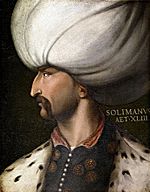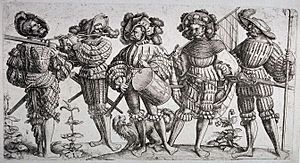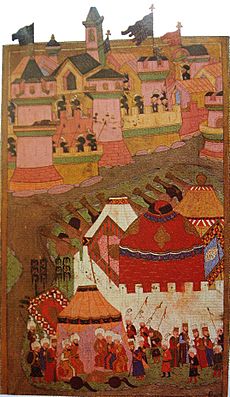Siege of Vienna (1529) facts for kids
Quick facts for kids Siege of Vienna |
|||||||
|---|---|---|---|---|---|---|---|
| Part of the Ottoman wars in Europe and the Ottoman–Habsburg wars | |||||||
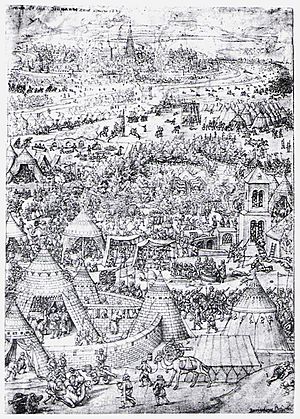 Contemporary 1529 engraving of clashes between the Austrians and Ottomans outside Vienna, by Bartel Beham |
|||||||
|
|||||||
| Belligerents | |||||||
|
|||||||
| Commanders and leaders | |||||||
| Niklas Graf Salm (WIA) Philipp der Streitbare Wilhelm von Roggendorf Petar Keglević Johann Katzianer Pavle Bakić |
Suleiman the Magnificent Pargalı Ibrahim Pasha |
||||||
| Strength | |||||||
| c. 17,000–21,000 |
c. 120,000–125,000 (only 100,000 were available during the siege) |
||||||
| Casualties and losses | |||||||
|
Unknown, with presumably high civilian fatalities More than 1,500 dead (10% of the besieged) |
15,000 wounded, dead or captured | ||||||
The Siege of Vienna in 1529 was the first time the powerful Ottoman Empire tried to capture Vienna. Vienna was the capital city of Austria and an important part of the Holy Roman Empire.
Suleiman the Magnificent, the leader of the Ottomans, attacked Vienna with over 100,000 soldiers. The city's defenders, led by Niklas Graf Salm, had only about 21,000 men. Even with fewer soldiers, Vienna managed to survive the attack. The siege lasted just over two weeks, from September 27 to October 15, 1529.
This attack happened after the Battle of Mohács in 1526. In that battle, the King of Hungary, Louis II, died. This led to a fight over who would rule Hungary. Two people claimed the throne: Archduke Ferdinand I of Austria and John Zápolya. Zápolya asked the Ottoman Empire for help and became their ally.
The Ottoman attack on Vienna was part of their plan to control Hungary. Historians still discuss what Suleiman's main goal was. Some think he wanted to fully control Hungary. Others believe he planned to use Hungary as a starting point to invade more of Europe. The failure of the Siege of Vienna started 150 years of conflict between the Habsburgs (who ruled Austria) and the Ottomans. This period ended with a second siege of Vienna in 1683.
Contents
Why the Siege Happened
In August 1526, Sultan Suleiman I won a big victory at the Battle of Mohács. This battle allowed the Ottomans to take control of southeastern Hungary. King Louis II of Hungary died during or after the battle.
His brother-in-law, Archduke Ferdinand I of Austria, claimed the Hungarian throne. Ferdinand was the brother of Holy Roman Emperor Charles V. However, Ferdinand was only recognized as king in western Hungary. A nobleman named John Zápolya also wanted to be king. He was from Transylvania. Suleiman recognized Zápolya as king in return for Zápolya becoming an Ottoman ally.
Because of this, Hungary was split into three parts: Royal Hungary (controlled by Ferdinand), Ottoman Hungary (controlled by the Ottomans), and the Principality of Transylvania (ruled by Zápolya). This arrangement lasted until 1700.
Ferdinand tried to take control of all of Hungary. He captured Buda in 1527. But in 1529, the Ottomans attacked again. Ferdinand lost all the land he had gained.
Getting Ready for Battle
The Ottoman Army Gets Ready
In the spring of 1529, Suleiman gathered a huge army in Ottoman Bulgaria. His goal was to secure control over all of Hungary. Some reports say his army had between 120,000 and 300,000 soldiers.
The Ottoman army included many different types of soldiers. There were Sipahi, who were elite horsemen. There were also thousands of Janissaries, who were highly trained infantry soldiers. Soldiers from Moldavia and Serbian fighters who supported John Zápolya also joined the army.
Suleiman led the army himself. In April, he made his top minister, Ibrahim Pasha, a special commander. Ibrahim Pasha could give orders in the Sultan's name.
Suleiman started his campaign on May 10, 1529. But they faced many problems from the start. It rained very heavily that spring in southeastern Europe. This caused floods and made the roads very muddy. Many large cannons and artillery pieces got stuck in the mud. Suleiman had to leave them behind. Camels from the eastern parts of the empire were not used to these conditions and many died. Sickness also spread among the Janissaries, causing many deaths.
Suleiman reached Osijek on August 6. On August 18, he arrived at the Mohács plain. There, John Zápolya and his cavalry joined him. Zápolya showed his loyalty to Suleiman. Together, they recaptured several forts from the Austrians, including Buda, which fell on September 8. The only resistance they met was at Pozsony. There, the Turkish fleet was attacked as it sailed up the Danube River.
Vienna Prepares to Defend Itself
As the Ottomans moved towards Vienna, the people of the city got ready to fight. Local farmers, peasants, and citizens formed a defense group. They were also helped by soldiers from other parts of Europe. These included German Landsknecht pikemen and skilled Spanish harquebusiers (soldiers with early firearms) sent by Charles V.
Queen Mary of Hungary, who was Charles V's sister, sent 700–800 Spanish harquebusiers. Only about 250 of these Spanish soldiers survived. These Spanish soldiers were led by Marshal Luis de Ávalos. They were very good at defending the northern part of the city. They prevented the Ottomans from setting up camp near the city walls. They also built extra fences and dug trap pits, which were very important during the siege.
Wilhelm von Roggendorf, a high-ranking official in Austria, was in charge of Vienna's defense. The actual command of the soldiers went to Nicholas, Count of Salm. He was a 70-year-old German mercenary who had fought bravely in the Battle of Pavia in 1525.
Salm arrived in Vienna with his mercenary soldiers. He immediately started making the city's three-hundred-year-old walls stronger. He set up his headquarters near St. Stephen's Cathedral. To make sure the city could last a long siege, he blocked the four city gates. He also made the walls thicker, as some were only six feet wide. He built earth mounds (bastions) and an inner earth wall. He even tore down buildings if they were in the way of the defenses.
The Siege Begins!
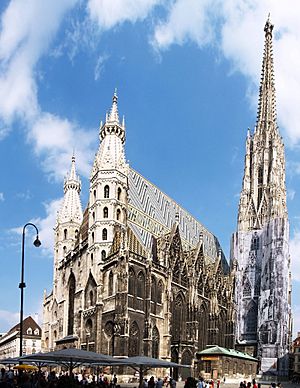
When the Ottoman army arrived in late September, it was not as strong as it had been. The long march into Austria had used up many camels and heavy cannons. Many soldiers were sick or tired from the difficult journey through the rainy season. About a third of the soldiers who were fit to fight were Sipahis, who were not good at attacking walled cities.
Suleiman sent three Austrian prisoners to Vienna to ask the city to surrender. Salm sent three richly dressed Muslim prisoners back without an answer. This showed he would not surrender.
As the Ottoman army got into position, the Austrian soldiers made quick attacks. They tried to stop the Ottoman sappers (soldiers who dig tunnels) from digging under the city walls. In one attack, they almost captured Ibrahim Pasha. The defenders also found and blew up several Ottoman mines that were meant to break through the walls. On October 6, 8,000 Austrian soldiers attacked the Ottoman digging operations. They destroyed many tunnels but lost many men because it was hard to get back to the city.
More rain fell on October 11. The Ottomans were still unable to break through the walls. Their chances of winning started to disappear. Suleiman's army also faced serious shortages of food, water, and other supplies. Many soldiers were getting sick, dying, or leaving the army. The Janissaries started to complain about the lack of progress. They demanded a decision on whether to stay or leave.
Suleiman held a meeting on October 12 to discuss what to do. They decided to try one last, big attack on Vienna. This was an "all or nothing" attempt. The attack happened on October 14. Even though extra rewards were offered to the soldiers, the attack was pushed back. The defenders' arquebuses (early firearms) and long pikes were very effective.
The next day, with supplies running low and winter coming, Suleiman called off the siege. He ordered his army to go back to Constantinople.
The retreat was difficult because of unusually heavy snowfall. The roads were muddy, and the horses and camels struggled to move. Austrian horsemen chased the retreating Ottomans and captured many soldiers who had fallen behind. However, the Austrians did not launch a full counter-attack. The Ottomans reached Buda on October 26, Belgrade on November 10, and Constantinople on December 16.
What Happened After
Some historians think that Suleiman's final attack was not meant to capture the city. Instead, it might have been to cause as much damage as possible. This would weaken Vienna for a future attack. He had used a similar tactic at Buda in 1526.
Suleiman did lead another campaign towards Vienna in 1532. But it never became a full siege. His army was stopped by the Croatian Captain Nikola Jurišić during the siege of Güns (Kőszeg). Nikola Jurišić and only 700–800 Croatian soldiers managed to delay the Ottoman army until winter arrived.
Charles V knew that Vienna was vulnerable. He gathered 80,000 soldiers to face the Ottomans. Instead of trying a second siege, the Ottoman army turned back. On their way, they destroyed the southeastern Austrian region of Styria. The two campaigns against Vienna showed how difficult it was for the Ottomans to send large armies deep into central Europe.
The 1529 campaign had mixed results. Buda was returned to John Zápolya, who was an Ottoman ally. This made the Ottoman position in Hungary stronger. The campaign also caused a lot of damage in nearby Habsburg Hungary and Austria. This made it harder for Ferdinand to attack back. However, Suleiman failed to make Ferdinand fight him in an open battle. So, Suleiman could not show that he was superior to the Habsburgs.
The attack on Vienna brought Charles V and Pope Clement VII closer together. It also led to the Pope crowning Charles V as Holy Roman Emperor on February 24, 1530. The Ottomans presented the outcome of the campaign as a success. They held grand ceremonies to celebrate the circumcision of princes Mustafa, Mehmed, and Selim.
Ferdinand I built a special monument for Nicholas, Count of Salm. This was to thank him for his efforts in defending Vienna. Nicholas survived the siege but was injured during the last Ottoman attack. He died on May 4, 1530. His tomb is now in the baptistery of the Votivkirche cathedral in Vienna. Ferdinand's son, Maximilian II, later built the Castle of Neugebaeude where Suleiman is believed to have set up his tent during the siege.
Images for kids
See also
 In Spanish: Sitio de Viena para niños
In Spanish: Sitio de Viena para niños


